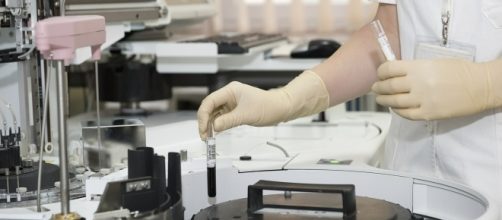Doctors around the world need blood centrifuged to separate plasma from blood cells or isolate the malaria parasite, but a centrifuge costs upwards of a thousand dollars or more and requires electricity putting them out of the reach of labs serving many third-world patients.
Early attempts
This is a well-known problem and over the years a number of people have tried to adapt everything from a “salad spinner” to egg beater designs to the task of preparing patients’ blood samples for diagnostic tests. Those failed because they weren't fast enough to duplicate the action of a commercial centrifuge.
Enter the whirligig
Now it has been demonstrated both mathematically and through practical tests that a 5,000-year-old toy consisting of a string and paper circle can produce centrifugal forces of 30,000 g at speeds reaching 125,000 r.p.m.
Total cost for the device should run about 5/$1. They could be manufactured locally in quantities in many places and sent to rural clinics.
The paperfuge
Developers who published a scientific paper describing the creation and testing of the device in Nature magazine (published online 10 January 2017 article number: 0009 (2017) doi:10.1038/s41551-016-0009) named their paper centrifuge design the paperfuge and the design is as described below. It seems likely that once they are made aware of the basic design which was developed and tested in a well-equipped lab, virtually anyone could make their own either using the same or other materials with just a bit of experimentation but a town where laser printers and supplies are available would be best.
The only lab grade parts are the disposable capillary tubes which, possibly along with the epoxy or glue, probably can’t be sourced locally.
Supplies needed
Dimensions will become obvious and aren’t critical.
- Card stock paper or thin plastic
- Strong string of some sort
- Two plastic straws
- Glue
- Two short sticks, wood dowels, pieces of plastic pipe, or similar to make handles
- SafeCrit microhematocrit heparinized capillary tubes, 22274913, Fisher Scientific
Directions
Following is the actual design tested - variations which have similar characteristics and safety features (samples could pose a dangerous biohazard) should also work. Many third-world individuals have probably made the very similar toy for kids.
- Cut two identical 50mm radius disks from the card stock.
- Mark two small holes (sized for the available string) 2.5 mm apart equidistant from the center of the discs. It is recommended to reinforce the holes with something.
- Cut the straw or straws into two 40mm lengths and seal one end of each with strong glue such as epoxy and when cured glue to one of the discs equidistance apart and inline with the center to ensure balance. The sealed ends go to the outer edge of the disc.
- Fill two capillary tubes with samples to the marked line and seal with more glue - wait until dried/cured.
- Attach 4 small pieces of Velcro to edges of the discs equal distances apart (90 degrees apart) and, after dropping two sealed sample holders into the straws (make sure they are nearly identical weights) and stick the discs together with the straws between them.
- Cut very strong but flexible string such as fishing line to a suitable length to loop through the disc and around both handles with room to work the device (length should be obvious).
- Pull the string into a long loop through the two holes and attach to two comfortable size handles such as pieces of PVC pipe but any suitable material to hold in your hand works.
- Now spin the disc by pulling your hands apart or together. Or read Nature article.
Tests
That design was tested repeatedly and worked safely and fast.
Hematocrit tests (blood separation) took 1.5 minutes with the paperfuge and 2 minutes with a medical lab grade $700 Critspin centrifuge. Other tests such as the one for detecting malaria in blood also worked, although that took 15 minutes.
The estimated total construction cost of the paperfuge was found to be about 20-cents.

